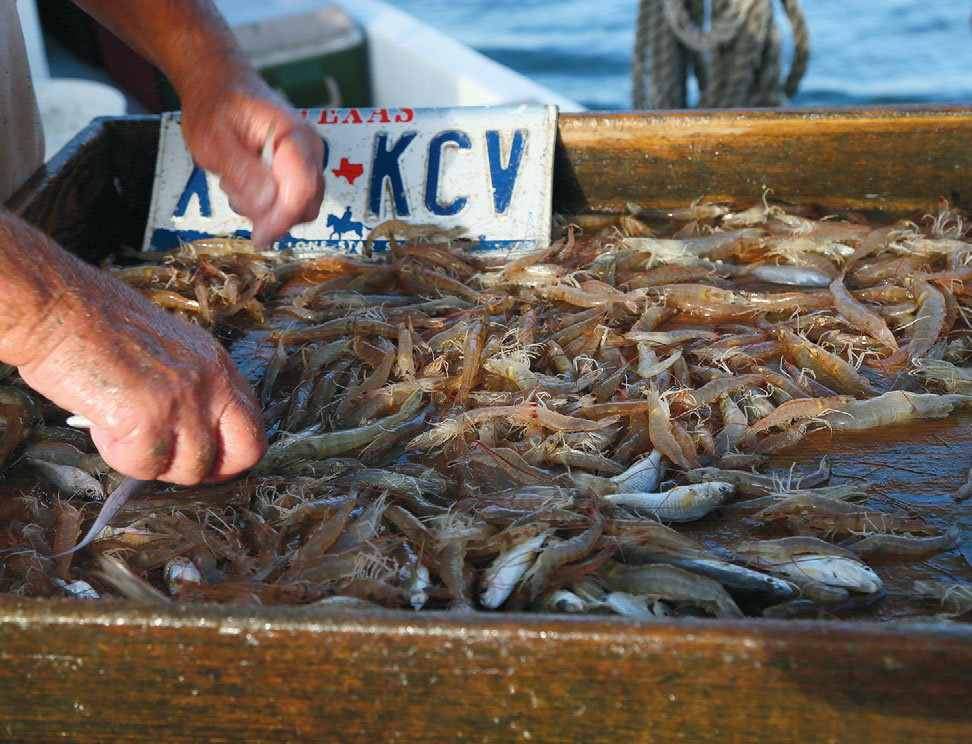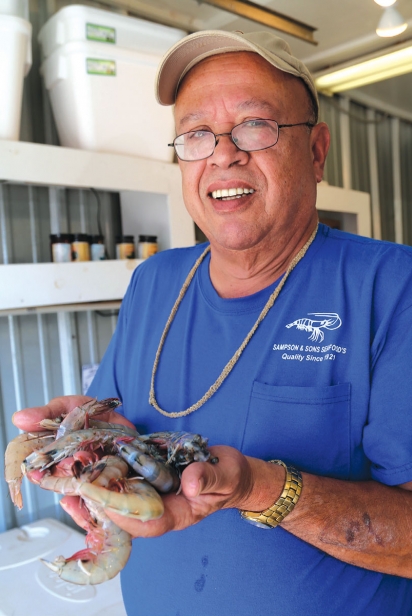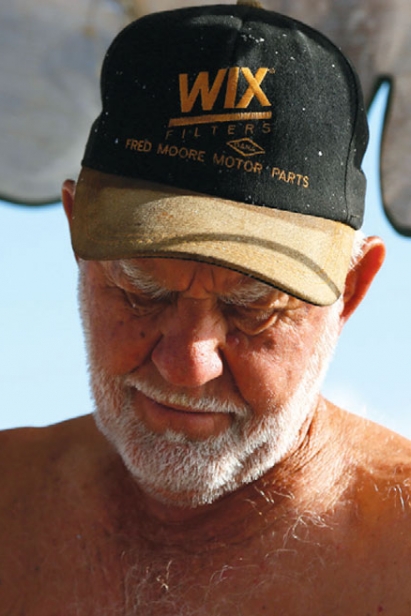Follow that Shrimp
It’s 4:30am and I’m strolling down Galveston’s Pier 19, peering at shrimp boat names in the predawn … ahhh, the St. Vincent; that’s it! I’m the guest this morning of father-and-son shrimpers Jerome and Booney Kunz, who greet me as I step aboard. We’re soon under way, joining the flotilla of shrimp boats heading out from the harbor into the bay.
Shrimp season has just reopened following a 60-day annual closure—Texas being the only state to close offshore waters to commercial shrimping to allow the maturation of juvenile shrimp before reopening the season each year—so the harbor’s bustling. My plan today is to follow shrimp from the boat to the kitchen and, ultimately, to the plate.
Unlike most of the other boats, which head out into the Gulf, the St. Vincent remains in the bay. Jerome, who started shrimping with his father when he was 10, transitioned to the lucrative live bait shrimp business when the influx of cheap imported shrimp depressed prices. He’s 82 now, and has been shrimping almost daily for 72 years, he tells me. “Retirement’s not for me,” says Jerome. “I don’t know what I would do with myself. I like being out on the water every morning.”
“Dad does take off for Christmas and Easter, though,” chuckles Booney, the eldest of Jerome’s 10 children, and a recent UTMB-Galveston retiree.
The brown shrimp larvae from the spring spawn got washed out from the estuaries with Memorial Day floods, they tell me. It’s yet to be determined whether they’ll show up late, or not at all; time will tell.
After about a 20-minute trawl, Jerome begins hauling in the catch, which he and Booney rapidly sort to get the shrimp into their large circulating water tank as quickly as possible. Male crabs go in a bucket—another of Jerome’s sons is arriving from New York today and wants a fresh crab supper—and the females get shuttled overboard. The small finfish, mostly menhaden, provide a feast for the gathering seagulls and pelicans as they and the rest of the bycatch get rinsed back into the bay through openings at the back of the deck. The St. Vincent will complete several more trawls before heading back to the harbor before 9am.
Except for the effort that goes into keeping the shrimp alive on the boat throughout the morning and at the dock until they are sold, the process for table shrimp is pretty much the same as for bait shrimp. The trawls have wing nets that meet in the middle in a cone-shaped net, which is lowered and dragged behind the boat. When the shrimper pulls up the net, the doors on the wing nets fall open, allowing him to deposit the catch in a holding tank or directly onto the deck. Nets are required by federal law to be outfitted with turtle-excluder devices (TEDs), to lessen bycatch mortality. While bycatch ratios could still be improved, and the damage that trawls do to the benthic zone (critters on the bay floor) could be lessened, wild-caught U.S. shrimp still earns the most points for sustainability when responsibly caught.
Most of these shrimp trawls are pretty ancient, but a bright spot in the industry is Environmental Trawling Solutions Inc., which has a U.S. patent pending for its state-of-the-art Wing Trawling System, now being testing in the Gulf of Mexico. The Wing Trawling System uses 50% less fuel by reducing drag and also cuts bycatch in half, releasing fish before they’re boated. It’s designed to float 18 inches above the bay bottom, leaving the benthic zone undisturbed.
In 1996, TPWD created an innovative voluntary commercial shrimp license buy-back program to cap the number of shrimpers plying our prolific bays. As of 2014, TPWD has bought back 2,145 commercial shrimp licenses to the tune of $14.2 million, reducing the number of shrimpers by a full two-thirds since the 1995 count of 3,231 commercial licenses. Of course, one can still seine or cast-net shrimp in Texas for personal use, year round, with a valid fishing license and saltwater endorsement.
Back at Pier 19, the seafood markets are bustling, with Sampson & Sons and the adjacent Katie’s Seafood loading in and icing down the morning’s fresh catch. “My grandfather opened this market shortly after arriving in Galveston in the early 1900s,” Milton Sampson tells me as he stacks bins holding the morning’s catch of blue crabs. “He had emigrated from the Ukraine to escape the persecution of Jews, and taught himself the trade. I learned the business from my dad, and I still love it every day. My son may or may not follow me into this business; that will be his choice.”
Weekends are particularly brisk, with both day-trippers and cruise vacationers stopping in for fresh seafood. Katie’s Seafood, arguably Galveston Bay’s leading fresh seafood wholesaler, operates a retail shop next door.
I “follow that shrimp” from Katie’s to one of the restaurants it supplies, BLVD. Seafood, a hip update of a former cinder-block-constructed convenience store on the Galveston Seawall that just opened shortly after Memorial Day. On the menu, owner-chef Mike Dean touts his commitment to locally sourced seafood from both Katie’s Seafood and the Galveston Island Shrimp Company. While the higher-priced local fresh seafood might be more the norm at restaurants on the tonier Strand—including Dean’s own establishment, Yaga’s—it’s the exception rather than the norm on the Seawall side, where cheaper eateries proliferate to serve beach-goers. I later ask Dean how his 3-month-old restaurant is faring.
“It was a calculated risk,” Dean admits. “But I’ve lived here all my life, and I wanted to bring back a bit of the grandeur of the Boulevard, which is what this was called before it became known as the Seawall. The response has been great. Folks want to be able to come to Galveston and eat fresh, local seafood and they’re willing to pay a higher price for that.” I can vouch for that: The perfectly grilled plump shrimp—crowning my BLVD. house salad of fresh local greens, spiced pecans, feta and strawberries, and shimmering in a gossamer glaze of fig sugarcane vinaigrette— most likely passed me in Galveston Bay that very morning.
Other Galveston restaurants serving fresh-from-the-bay shrimp and crab range from the venerable Gaido’s (established in 1911) and the elegant Galvez Hotel to the brilliantly executed fare at Shrimp ’N Stuff and Jimmy’s on the Pier, a farm-to-table restaurant run by restaurateurs Jimmy and Kelli McClure, who supplement their establishment’s fresh seafood with produce from their organic farm on the Island’s West End.
And as much shrimp as Dean might go through at the BLVD. and Yaga’s, he’ll place a ginormous order for his Galveston Shrimp Festival, Sept. 25–27. “Last year, we went through well over 10,000 pounds of shrimp,” he says, “with 13 pro teams and 48 amateur ones. I expect it will be at least that this year.” Dean launched the Galveston Shrimp Festival after Hurricane Ike. “I thought of things Galveston didn’t have, but should,” he says. He patterned the Shrimp Festival after his successful Wild Game Cookoff, which he started in 1994; to date, his company, Yaga Presents, has contributed more than $1.2 million to Galveston County’s children’s charities.
For folks such as these, from father-and-son shrimpers plying their nets, to the three generations who have run Sampson & Sons Seafood, to the restaurateur who pays it forward to the local children’s charities, to the coastal biologists who dedicate their careers to assuring a sustainable future for these crustaceans, to those of us who love dining on them, the humble shrimp and crab do far more than fuel a multimillion-dollar fishery.
They bind us, and the families who bring them to us, to Galveston Bay; they give us a deeper appreciation of the bountiful resource at our doorstep; and they instill in us the desire to cherish, protect and conserve this valuable resource.







